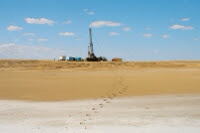MORRY-JE-WANDH, Pakistan (AlertNet) – Wearing colourful traditional dresses with silver jewellery and bangles on their arms, the women of Tharparkar district look festive. But the empty earthen pots they carry tell a different story.
 |
| Women of Tharparkar district |
“Walking for three miles and (hoisting) a ... bucket filled with water through a wooden pulley from a 130-feet-deep well twice a day is toilsome work,” says Marvi Bheel, who lives in isolated Morry-je-Wandh village in this arid district of Sindh province, some 450 km (280 miles) south-east of Karachi.
Increasing temperatures and lower rainfalls, believed to be associated with climate change, are creating intense water shortages in much of Pakistan, a situation which is likely to worsen if the country’s 170 million population doubles as projected in the next 25 years.
In response, non-governmental organizations are trying to improve water harvesting in rural areas. A pilot project in Morry-je-Wandh has seen the construction of a large covered pond with the capacity to supply the domestic and drinking water needs of 20 families (135 villagers) for more than eight months.
“The new rainwater harvesting facilities have transformed the lives of people, as we have now a safe source of clean water,” said Sobho Bheel, a farmer unrelated to Marvi Bheel.
The effects of having a good supply of drinking water at hand are far-reaching, he added: diseases have diminished, children can go to school and women have more time to spend on other economic activities.
IMPROVING LIFE FOR WOMEN
Women in Tharparker district, as in many places around the world, are charged with the task of gathering water. But as water becomes scarcer, travelling long distances to collect it can be arduous.
“Women fall unconscious on their way to these dug wells, while others develop pregnancy related complications due to being malnourished,” Marvi Bheel said. On summer days temperatures hover around 48 to 50 degrees Celsius (118 to 122 degrees Fahrenheit), and the falling water table means that water sometimes has to be hauled from a depth of 200 to 250 feet (62 to 77 metres).
Dug wells are the major source of water for over 90 percent of the approximately 1.4 million people living in Tharparkar, Pakistan’s largest arid district, which spreads over nearly 20,000 square kilometres (7,600 square miles) and comprises some 2,350 villages.
Water is taken from the wells for domestic, agriculture and livestock needs. But because of the inadequate number of wells in the district and demand for water exceeding supply, wells often produce too little water or dry up within several months of being recharged by rain.
Bharumal Armani of Chelhar village recalls that during August 2010, rains in the Thar Desert recharged parched shallow wells, raised the water table in deep wells and filled household cisterns.
But after four months, local people were without sufficient water even for drinking. Many villagers had to walk miles to fetch supplies, while herdsmen were forced to take their livestock to reservoirs to water them.
According to a study by the Pakistan Council for Research on Water Resources (PCRWR), a government body, the entire Thar Desert receives between 260 and 280 mm (1.0-1.1 inches) of rainfall annually. The scanty precipitation, however, could suffice to meet the domestic water needs of the locals and their livestock for three years, according to the PCRWR.
95 PERCENT OF RAINFALL LOST
But because of inadequate storage and rainwater harvesting facilities, more than 95 percent of the water is lost under sand dunes or evaporates in the summer heat.
“Hardly 0.06 percent of the total annual rainwater is harvested by the locals in their household cisterns or in other indigenous ways,” said A.D. Khan, director for groundwater management at the water council. Khan believes the water shortage problem can be addressed by scaling up rainwater harvesting to at least 0.25 percent of the annual rainfall.
In Morry-je-Wandh, a water storage pond with a cover to curb evaporation is part of that effort. The pond, constructed by the Sukkar Foundation, a non-governmental organisation, cost Rs. 125,000 (about $1,400) and relied on financial and technical support from WaterAid-UK’s Pakistan chapter.
“We lay a geo-membrane sheet under the floor of these (ponds) to check seepage, and cover them with roofs that help check evaporation of stored rainwater during the sizzling summer days,” said Abdul Hafeez, WaterAid’s national programme manager.
Using hand pumps connected to the storage ponds through pipes, women can fill their pitchers with water without any difficulty.
According to Qamar uz Zaman Chaudhry, Pakistan’s advisor on climate change affairs, the country is one of the world’s most arid. Most areas have little or no access to surface water. By international standards, Pakistan was already considered a water-scarce country in 1992 with an annual per capita availability of 1,700 cubic metres. This has now declined to fewer than 1,100 cubic metres, according to the government.
“The situation will grow tenser as rains are becoming more erratic and scarce due to climate change,” said Chaudhry, who is author of Pakistan’s national climate change policy.
Climate change and overuse of limited water is expected to create severe problems for the country in coming years, according to Simi Kamal, chairperson of the Hisar Foundation for Water, Food and Livelihood Security, promotes water conservation and management practices in Pakistan.
Annual per capita availability of water may fall to half its current level by 2020 if the depletion of water resources goes unchecked, she said. She believes much of the solution to growing water stress lies in planning and implementing workable rainwater harvesting programmes at medium and small levels.
Chaudhry agrees.
“More than adequate water can be made available for domestic, agriculture, industrial, livestock and other miscellaneous needs, provided that viable strategic plans are drawn up and implemented for rainwater harvesting at all levels,” he said. More
Saleem Shaikh and Sughra Tunio are development reporters based in Karachi, Pakistan.





